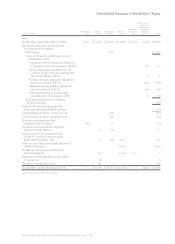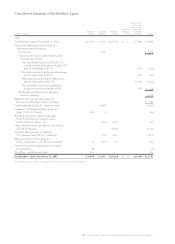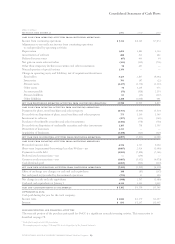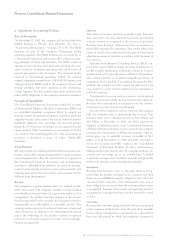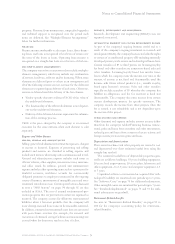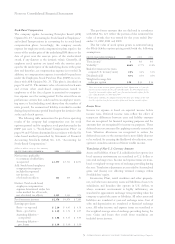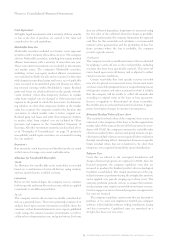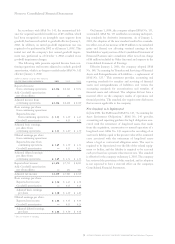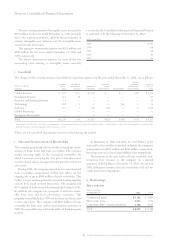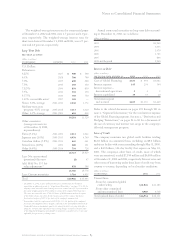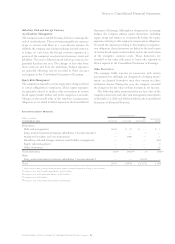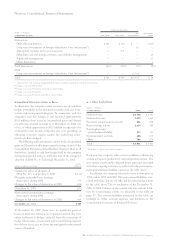IBM 2002 Annual Report Download - page 79
Download and view the complete annual report
Please find page 79 of the 2002 IBM annual report below. You can navigate through the pages in the report by either clicking on the pages listed below, or by using the keyword search tool below to find specific information within the annual report.Notes to Consolidated Financial Statements
77international business machines corporation and Subsidiary Companies
In July 2002, the FASB issued SFAS No. 146, “Accounting
for Costs Associated with Exit or Disposal Activities.” SFAS
No. 146 supersedes EITF No. 94-3, “Liability Recognition for
Certain Employee Termination Benefits and Other Costs to
Exit an Activity (Including Certain Costs Incurred in a
Restructuring),” and requires that a liability for a cost associ-
ated with an exit or disposal activity be recognized when the
liability is incurred. Such liabilities should be recorded at fair
value and updated for any changes in the fair value each
period. A notable change from EITF No. 94-3 involves one-
time employee termination costs whereby the employee to be
terminated is required to render service between the notifica-
tion date and the date the employee will be terminated in
order to receive any termination benefits. For these situations
whereby the required postnotification service period extends
beyond the minimum retention period required by local law,
the fair value of the liability will be recognized ratably over the
service period. This change is effective for new exit or disposal
activities initiated after December 31, 2002. Had SFAS No. 146
been effective for the company’s second quarter and fourth
quarter 2002 actions, a portion of the pre-tax employee ter-
mination costs listed in the table on pages 91 and 92 would
have been amortized over the applicable service periods, until
the respective employees were terminated. The impact of
SFAS No. 146 on the company’s future Consolidated Financial
Statements will depend upon the timing of and facts under-
lying any future one-time workforce reduction actions.
In November 2002, the EITF reached a consensus on
Issue No. 00-21, “Accounting for Revenue Arrangements
with Multiple Deliverables.” This Issue provides guidance on
when and how to separate elements of an arrangement that
may involve the delivery or performance of multiple products,
services and rights to use assets into separate units of account-
ing. The guidance in the consensus is effective for revenue
arrangements entered into in fiscal periods beginning after
June 15, 2003. The company will adopt Issue No. 00-21 in
the quarter beginning July 1, 2003. The transition provision
allows either prospective application or a cumulative effect
adjustment upon adoption. The company is currently evalu-
ating the impact of adopting this guidance.
In November 2002, the FASB issued Interpretation No. 45
(FIN 45), “Guarantor’s Accounting and Disclosure Require-
ments for Guarantees, Including Indirect Guarantees of
Indebtedness of Others,” which addresses the disclosures to
be made by a guarantor in its interim and annual financial
statements about its obligations under guarantees. FIN 45
also requires the recognition of a liability by a guarantor at
the inception of certain guarantees that are entered into or
modified after December 31, 2002.
The company has adopted the disclosure requirements of
FIN 45 (see note a, “Significant Accounting Policies,” on pages
70 through 75, and note o, “Contingencies and Commit-
ments,” on pages 88 and 89) and will apply the recognition
and measurement provisions for all material guarantees
entered into or modified in periods beginning January 1,
2003. The impact of FIN 45 on the company’s future
Consolidated Financial Statements will depend upon
whether the company enters into or modifies any material
guarantee arrangements.
In January 2003, the FASB issued Interpretation No. 46
(FIN 46), “Consolidation of Variable Interest Entities,”
which addresses consolidation by business enterprises of vari-
able interest entities that either: (1) do not have sufficient
equity investment at risk to permit the entity to finance its
activities without additional subordinated financial support,
or (2) the equity investors lack an essential characteristic of a
controlling financial interest.
FIN 46 requires disclosure of Variable Interest Entities
(VIEs) in financial statements issued after January 31, 2003, if
it is reasonably possible that as of the transition date: (1) the
company will be the primary beneficiary of an existing VIE
that will require consolidation or, (2) the company will hold a
significant variable interest in, or have significant involvement
with, an existing VIE. Pursuant to the transitional require-
ments of FIN 46, the company will adopt the consolidation
guidance applicable to existing VIEs as of the reporting period
beginning July 1, 2003. Any VIEs created after January 31,
2003, are immediately subject to the consolidation guidance
in FIN 46.
The company’s program to sell state and local government
receivables, as described in note j, “Sale and Securitization of
Receivables,” on page 82, involves qualifying special purpose
entities, and therefore is not subject to FIN 46.
The company does not have any entities that require
disclosure or new consolidation as a result of adopting the
provisions of FIN 46.


